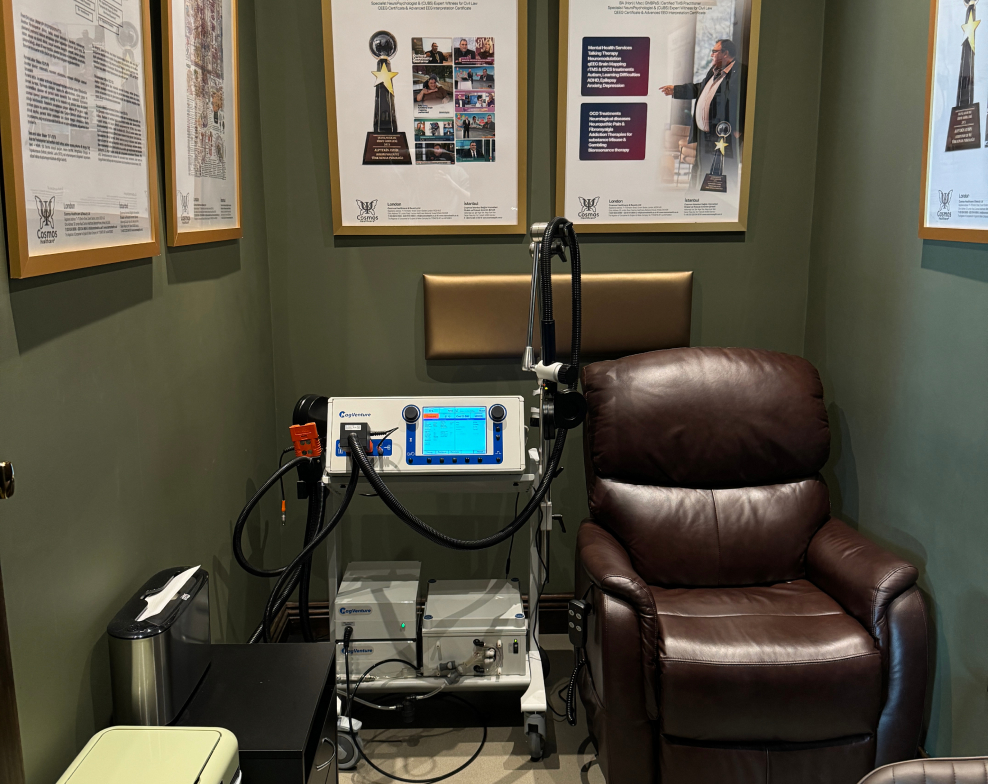

This article explores how Primary Progressive Aphasia (PPA) can be treated using qEEG-Guided Home-Based tDCS Neuromodulation.
Primary Progressive Aphasia presents as a degenerative brain disorder which steadily reduces a person’s capacity for language processing along with speech understanding and communication abilities. Primary Progressive Aphasia (PPA) represents a form of Frontotemporal Dementia (FTD) which targets the frontal and temporal lobes that govern speech production, word retrieval, and sentence comprehension.
PPA’s progressive nature and lack of a cure require treatment strategies that enhance neural function and brain plasticity to slow down language decline.
Transcranial Direct Current Stimulation (tDCS) stands out as one of the most effective intervention methods because it combines non-invasive brain stimulation with portable qEEG-guided Neuromap analytics to deliver personalized therapeutic solutions for home use.
The QPAN Model and Neuromap Algorithm utilize functional brain mapping with AI-driven analysis to create precise stimulation protocols that deliver targeted neuromodulation adaptable to each patient’s changing cognitive and linguistic requirements.
How Home-Based tDCS Neuromodulation Helps PPA Patients
The technique of tDCS (Transcranial Direct Current Stimulation) delivers low-intensity electrical stimulation which enhances neuronal excitability to support synaptic plasticity development. tDCS devices provide portable, safe at-home treatment options that can be used non-invasively to deliver patient-specific long-term stimulation according to their individual neurological needs.
Quantitative EEG mapping enables individualized tailoring of transcranial Direct Current Stimulation therapy for PPA patients at home.
Treating PPA faces the critical challenge of identifying the best stimulation points within the brain’s language network. The real-time neural activity evaluation from qEEG functional brain mapping enables Neuromap’s AI algorithm to identify the most affected brain areas and customize stimulation to fit the patient.
qEEG scans of PPA patients typically reveal:
– The left inferior frontal gyrus (Broca’s area) shows reduced activity which causes problems with speech production and articulation.
– The left posterior superior temporal gyrus (Wernicke’s area) disruptions lead to problems with understanding language and processing sentences.
– Reduced connections between the left temporal and parietal lobes cause problems with finding words and maintaining semantic memory.
– The condition of asymmetrical brainwave activity results in a weakened left hemisphere which demands stimulation to boost compensatory functions.
Neuromap develops a specialized tDCS protocol through analysis of brain abnormalities to activate inactive regions and suppress excessive activity which leads to stabilized neural networks and enhanced language abilities.
Home-Based qEEG-Guided tDCS treatment offers significant advantages for patients with Primary Progressive Aphasia.
1. Improving Language Fluency and Sentence Formation
– TDCS applied to Broca’s area improves neural activity in non-fluent PPA patients which results in better fluency and sentence formation.
– The optimization of tDCS stimulation parameters according to each person’s specific neurophysiological state through qEEG-based personalization results in significant enhancements of spontaneous speech and conversational skills.
2. Enhancing Word Retrieval and Memory Recall
– People with logopenic variant PPA (lvPPA) demonstrate difficulties in retrieving words and repeating sentences.
– Application of tDCS to the left posterior superior temporal gyrus and angular gyrus leads to enhanced phonological access and word retrieval skills while decreasing speech hesitation and retrieval failure events.
– The use of qEEG-guided tDCS enabled patients to achieve quicker reaction times during lexical access tasks which supports its effectiveness for treating word retrieval deficits.
3. Research reveals that targeted tDCS can prevent further semantic memory decline in individuals with svPPA.
– Semantic variant PPA (svPPA) leads to patients losing their ability to understand words as well as recognize objects.
– Stimulation of the left anterior temporal lobe through tDCS enhances conceptual processing and word understanding which results in delayed cognitive decline and extended semantic memory preservation.
– The Neurology journal published findings from a longitudinal study that showed repeated tDCS treatment of the ATL in svPPA patients delayed brain atrophy and maintained language skills for up to 12 months after treatment.
4. Strengthening Cognitive Resilience Through Neural Network Reinforcement
– Because PPA shows progressive characteristics, tDCS therapy aims to maximize brain neuroplasticity while promoting the development of compensatory neural pathways.
– Left dorsolateral prefrontal cortex (DLPFC) stimulation improves cognitive flexibility enabling patients to deal with language difficulties while preserving executive functions.
– The implementation of qEEG-guided tDCS allowed patients to enhance their verbal working memory and processing speed which enabled them to participate more effectively in daily conversations and social interactions.

Scientific Evidence Supporting Home-Based tDCS for PPA
The latest research demonstrates tDCS as an effective treatment for PPA that helps maintain language skills.
– According to a randomized controlled trial published in the Journal of Neurolinguistics tDCS stimulation of the left frontal cortex produced measurable enhancements in speech fluency and grammatical complexity among non-fluent primary progressive aphasia patients.
– The study from 2022 published in Frontiers in Neuroscience demonstrated that home-based tDCS treatments based on individual qEEG assessments led to substantial language comprehension and word retrieval improvements which persisted after treatment cessation.
– Brain Stimulation published a systematic review demonstrating that tDCS treatment over Wernicke’s and Broca’s areas led to lasting improvements in both expressive and receptive language capabilities and indicated its potential to decrease speech deterioration in PPA patients.
Research findings validate that qEEG-guided tDCS effectively preserves language abilities and postpones disease progression which establishes it as an essential component for personalized PPA treatment.
Patients with Primary Progressive Aphasia require home-based qEEG-guided tDCS because it serves as an essential treatment method.
tDCS provides a powerful intervention for PPA patients by targeting language decline at its neurological core unlike traditional speech therapy or drug treatments. Home administration of tDCS with remote clinical oversight allows for:
– The maintenance of neuroplastic changes requires regular and steady neuromodulation.
– Real-time qEEG tracking allows for the instant adjustment of treatment protocols to enhance treatment effectiveness.
– The new method enables better access and compliance especially for people facing mobility limitations.
Advanced neuroimaging combined with artificial intelligence and home-based neuromodulation makes qEEG-guided tDCS an innovative personalized treatment strategy for PPA that brings new hope to patients and their families.
The Future of Personalized Neuromodulation for PPA
The ongoing progress in neuroscience and neurotechnology places qEEG-guided home-based tDCS at the forefront of transforming PPA treatment methods.
– Early-stage treatment offers preventive measures to postpone the emergence of serious language deficits.
– Dynamic treatment personalization provides optimized neural stimulation adapted to meet each individual’s unique requirements.
– By sustaining cognitive abilities for extended durations patients experience better life quality while maintaining their independence.
The QPAN Model and Neuromap Algorithm implement machine learning alongside qEEG analytics and neuromodulation to establish a precise data-centric solution for PPA patients which modifies management practices for language-related brain degeneration in both clinical and home environments.